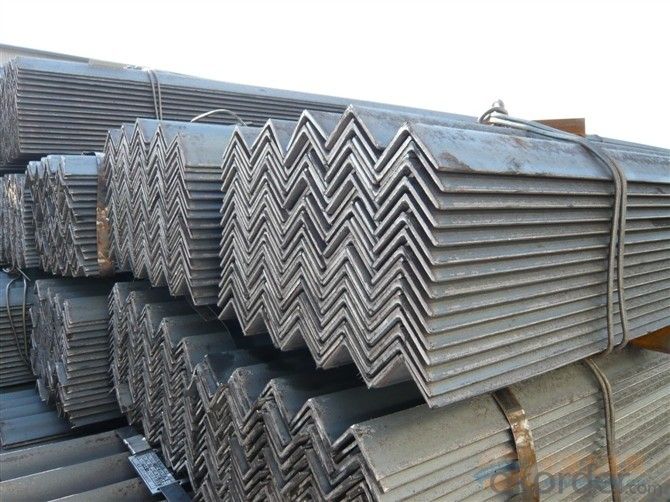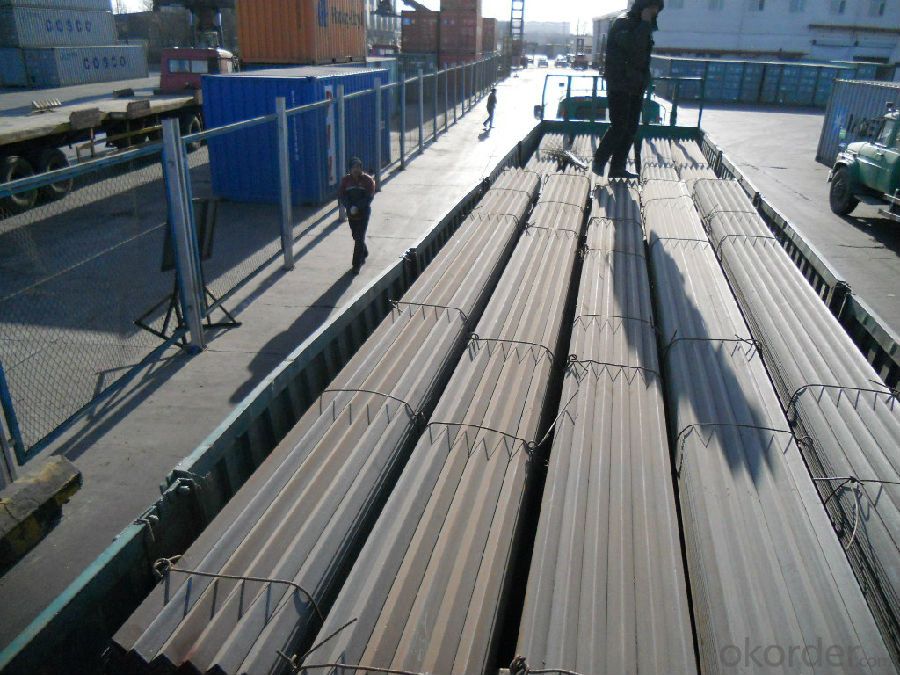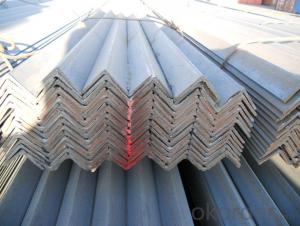Hot Rolled Steel Angle Bar with High Quality 90*90mm
- Loading Port:
- Tianjin
- Payment Terms:
- TT OR LC
- Min Order Qty:
- 25 m.t
- Supply Capability:
- 10000 m.t/month
OKorder Service Pledge
OKorder Financial Service
You Might Also Like
Product Description
Specifications of Equal Angle Steel
1.Standards:GB
2.Length:6m, 12m
3.Material:GBQ235 or Equivalent
4. Size:
Size (mm) | Mass (mm) | Size (mm) | Mass (mm) |
| 90*90*7 | 9.656 | 90*90*10 | 13.478 |
| 90*90*8 | 10.946 |
Usage & Applications of Equal Anlge Steel
Trusses;
Transmission towers;
Telecommunication towers;
Bracing for general structures;
Stiffeners in structural use.
Packaging & Delivery of Equal Angle Steel
1. Transportation: the goods are delivered by truck from mill to loading port, the maximum quantity can be loaded is around 40MTs by each truck. If the order quantity cannot reach the full truck loaded, the transportation cost per ton will be little higher than full load.
2. With bundles and load in 20 feet/40 feet container, or by bulk cargo, also we could do as customer's request.
3. Marks:
Color mark: There will be color marking on both end of the bundle for the cargo delivered by bulk vessel. That makes it easily to distinguish at the destination port.
Tag mark: There will be tag mark tied up on the bundles. The information usually including supplier logo and name, product name, made in China, shipping marks and other information request by the customer.
If loading by container the marking is not needed, but we will prepare it as customers' request.
FAQ:
Q1: Why buy Materials & Equipment from OKorder.com?
A1: All products offered byOKorder.com are carefully selected from China's most reliable manufacturing enterprises. Through its ISO certifications, OKorder.com adheres to the highest standards and a commitment to supply chain safety and customer satisfaction.
Q2: How do we guarantee the quality of our products?
A2: We have established an advanced quality management system which conducts strict quality tests at every step, from raw materials to the final product. At the same time, we provide extensive follow-up service assurances as required.
Q3: How soon can we receive the product after purchase?
A3: Within three days of placing an order, we will arrange production. The shipping date is dependent upon the quatity, how many sizes you want and the plan of production, but is typically 30 to 45 days from the beginning of production.
Images:


*If you would like to get our price, please inform us the size, standard/material and quantity. Thank you very much for your attention.
- Q:What are the limitations of using steel angles?
- There are several limitations associated with the use of steel angles in various applications. Firstly, steel angles have a limited load-bearing capacity. The weight and pressure that can be safely supported by a steel angle are determined by its size, shape, and material composition. If the load exceeds the weight-bearing capacity of the angle, it can lead to structural failure or deformation. Secondly, steel angles are susceptible to corrosion. They are typically made of carbon steel, which can rust over time when exposed to moisture or corrosive environments. This corrosion weakens the structural integrity of the angle, reducing its lifespan and potentially compromising the overall stability of the structure it supports. Additionally, steel angles may have limitations in terms of their flexibility and versatility. Due to their fixed shape and size, they may not be suitable for applications that require intricate or complex designs. In such cases, alternative materials or fabrication methods may be more appropriate. Another limitation of steel angles is their limited resistance to fire. Steel, including steel angles, loses its strength and structural integrity at high temperatures. In the event of a fire, steel angles may not be able to withstand the heat and can deform or collapse, jeopardizing the safety of the structure and its occupants. Lastly, steel angles can be challenging to work with during installation or modification. Their rigid nature may require specialized tools, equipment, or expertise for cutting, drilling, or welding. This can add to the overall cost and time required for construction or renovation projects. Despite these limitations, steel angles remain widely used in various industries due to their affordability, durability, and versatility within their design limits. However, it is essential to consider these limitations and evaluate the specific requirements of each application to determine if steel angles are the most suitable choice.
- Q:What are the different testing methods for steel angles?
- There are several testing methods for steel angles, including visual inspection, dimensional measurement, hardness testing, chemical analysis, and mechanical testing. Visual inspection involves examining the angles for any visual defects or irregularities. Dimensional measurement ensures that the angles meet the specified size and shape requirements. Hardness testing determines the hardness of the steel, which is an important factor in its strength and durability. Chemical analysis is performed to check the composition and purity of the steel, ensuring that it meets the required standards. Mechanical testing involves subjecting the steel angles to various loads and stresses to evaluate their mechanical properties such as strength and ductility.
- Q:Can steel angles be used for signposts?
- Yes, steel angles can be used for signposts. They are commonly used in construction and are known for their strength and durability, making them suitable for supporting signs.
- Q:Can steel angles be used as lintels or beams in construction?
- Yes, steel angles can be used as lintels or beams in construction. Steel angles provide strength and stability, making them suitable for supporting loads and distributing weight in structural applications. They are commonly used as lintels or beams to provide structural support over openings such as windows or doors.
- Q:What are the different types of connections used for steel angles in industrial settings?
- Depending on the specific application and structural requirements, steel angles in industrial settings can be connected using various types of connections. Some commonly used connection types include: 1. Welded Connections: When high strength and rigidity are needed, welding is a popular method for connecting steel angles. This involves joining the angles using heat and pressure, resulting in a strong and durable connection. 2. Bolting Connections: Bolts and nuts are used to connect steel angles in this type of connection. It allows for easy assembly and disassembly, making it suitable for applications that require flexibility and adjustability. Bolting connections can be tightened or loosened as needed. 3. Riveted Connections: Metal rivets are used to connect steel angles in this type of connection. It offers good strength and stability and is commonly used in heavy-duty applications. Riveted connections require specialized equipment and skilled labor for installation and removal. 4. Adhesive Connections: Adhesives can be used to bond steel angles together. This type of connection provides good load distribution and is suitable for applications where welding or bolting is not feasible. Adequate surface preparation and adhesive selection are important for ensuring a strong bond. 5. Mechanical Connections: Cleats, brackets, plates, or clips can be used as mechanical connections to connect steel angles. These connections provide flexibility and ease of installation, allowing for adjustments and modifications in the future if necessary. It is important to consider factors such as load-bearing capacity, structural design, safety considerations, and environmental conditions when selecting the appropriate connection type for steel angles in industrial applications. Consulting with structural engineers and following industry standards and codes is crucial to ensure the correct connection type is used.
- Q:Are steel angles vulnerable to rusting?
- Yes, steel angles are vulnerable to rusting. Steel is primarily made of iron, which is highly susceptible to rusting when exposed to moisture and oxygen. If the steel angles are not properly protected with a corrosion-resistant coating or paint, they can easily develop rust over time. This can weaken the structural integrity of the angles and ultimately compromise their functionality. Regular maintenance and appropriate rust prevention measures, such as painting or galvanizing, should be undertaken to mitigate the risk of rusting and prolong the lifespan of steel angles.
- Q:How do you determine the shear capacity of a steel angle?
- To determine the shear capacity of a steel angle, several factors need to be considered. The shear capacity is the maximum load that the angle can sustain without failure in shear. The first step in determining the shear capacity is to identify the properties of the steel angle, such as the material grade and dimensions. The grade of the steel determines its strength properties, which are crucial for calculating the shear capacity. The dimensions of the angle, including the length, width, and thickness, will also play a significant role in the calculations. Next, it is necessary to determine the critical shear area of the angle. This area represents the portion of the angle that will experience the highest shear stress during loading. The critical shear area can be calculated by considering the location of the applied load and the geometry of the angle. Once the critical shear area is determined, the next step is to calculate the shear stress acting on this area. The shear stress is calculated by dividing the applied load by the area. It is important to ensure that the shear stress does not exceed the allowable shear stress for the specific grade of steel being used. The allowable shear stress is typically provided by design codes or standards. Finally, the shear capacity of the steel angle can be calculated by multiplying the shear stress by the critical shear area. This calculation provides the maximum load that the angle can sustain without failure in shear. It is important to note that the shear capacity of a steel angle may be influenced by other factors such as the presence of holes or welds, which can weaken the structure. In such cases, additional calculations or considerations may be required. Overall, determining the shear capacity of a steel angle involves considering the properties of the steel, calculating the critical shear area, determining the shear stress, and ensuring that it does not exceed the allowable shear stress for the material grade.
- Q:Can steel angles be used in furniture manufacturing?
- Yes, steel angles can be used in furniture manufacturing. Steel angles are commonly used as structural supports in furniture construction due to their strength and stability. They can be utilized for creating sturdy frames, legs, and corners in various types of furniture such as tables, chairs, and shelving units.
- Q:Can steel angles be used as handrails?
- Yes, steel angles can be used as handrails. Steel angles are commonly used in construction and can provide strength and durability when used as handrails. They can be easily installed and offer a stable grip for users. However, it is important to ensure that the steel angles meet safety standards and comply with local building codes to ensure the handrails can support the required load and provide adequate protection for users.
- Q:How do steel angles perform in chemical industry applications?
- Steel angles are widely used in chemical industry applications due to their excellent performance in corrosive environments. These angles, made of high-strength steel, exhibit exceptional resistance to chemicals, acids, and other corrosive substances commonly found in the chemical industry. The chemical industry often involves the handling and processing of various chemicals, which can lead to corrosion and degradation of structural materials. Steel angles, with their high corrosion resistance, provide a reliable and durable solution in such environments. Moreover, steel angles offer excellent load-bearing capacity and structural stability, making them ideal for supporting heavy equipment, tanks, and platforms in chemical plants. Their versatility allows for the construction of various structures and equipment, ensuring the safe and efficient operation of chemical processes. Steel angles can be fabricated into different sizes and shapes, allowing for easy customization to meet specific requirements. This versatility makes them suitable for a wide range of applications such as piping systems, storage tanks, chemical reactors, and support structures. In addition to their corrosion resistance and structural strength, steel angles are also cost-effective. They have a long lifespan, require minimal maintenance, and can withstand extreme temperatures, pressures, and chemical exposures. This durability and low maintenance requirement contribute to reducing downtime and overall operating costs in the chemical industry. Overall, steel angles perform exceptionally well in chemical industry applications by providing a combination of corrosion resistance, structural strength, versatility, and cost-effectiveness. Their ability to withstand harsh chemical environments makes them an essential component in the safe and efficient operation of chemical processes.
1. Manufacturer Overview |
|
|---|---|
| Location | |
| Year Established | |
| Annual Output Value | |
| Main Markets | |
| Company Certifications | |
2. Manufacturer Certificates |
|
|---|---|
| a) Certification Name | |
| Range | |
| Reference | |
| Validity Period | |
3. Manufacturer Capability |
|
|---|---|
| a)Trade Capacity | |
| Nearest Port | |
| Export Percentage | |
| No.of Employees in Trade Department | |
| Language Spoken: | |
| b)Factory Information | |
| Factory Size: | |
| No. of Production Lines | |
| Contract Manufacturing | |
| Product Price Range | |
Send your message to us
Hot Rolled Steel Angle Bar with High Quality 90*90mm
- Loading Port:
- Tianjin
- Payment Terms:
- TT OR LC
- Min Order Qty:
- 25 m.t
- Supply Capability:
- 10000 m.t/month
OKorder Service Pledge
OKorder Financial Service
Similar products
New products
Hot products
Related keywords




























